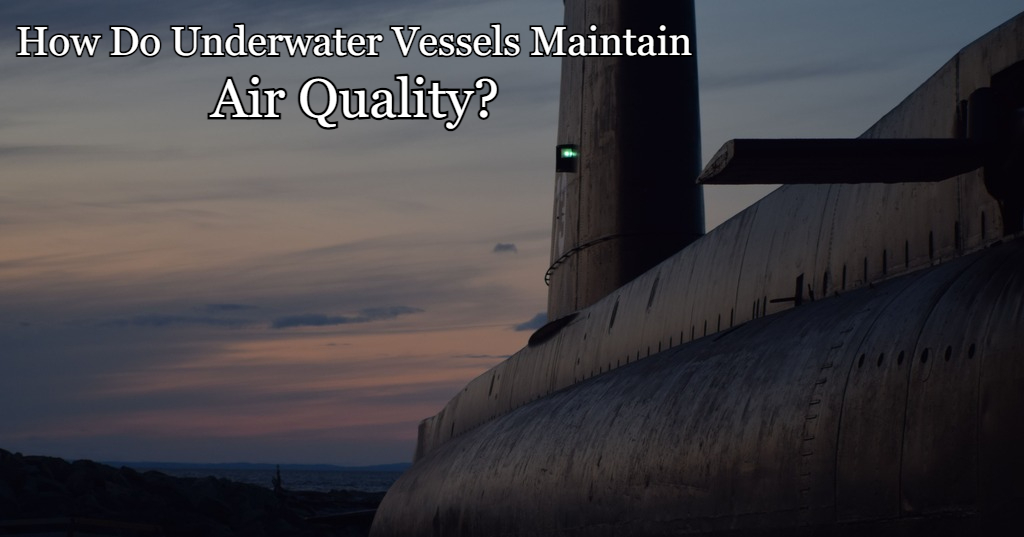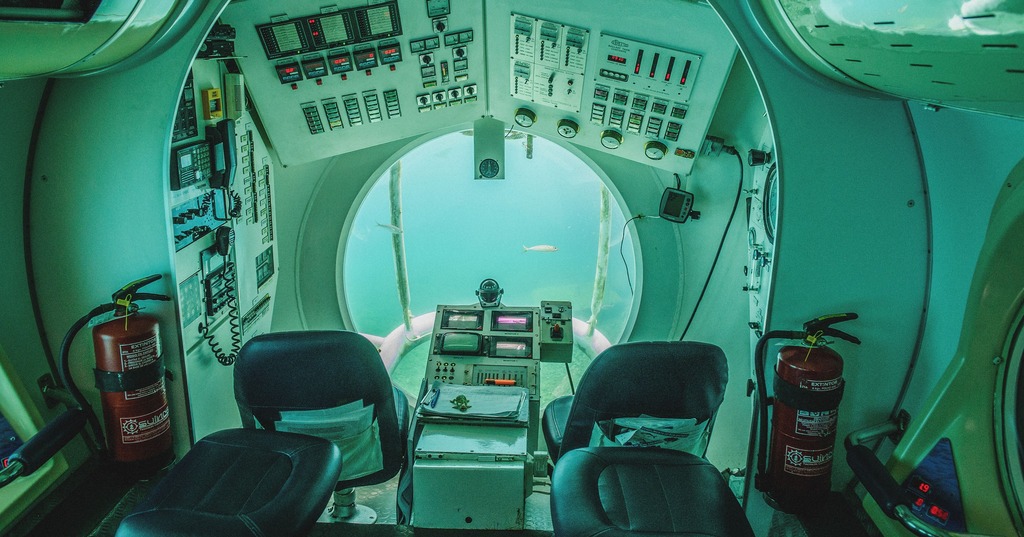Submarines serve various commercial, recreational, educational and military purposes. However, their underwater operations make it difficult to ensure the crew’s health and safety — especially regarding air quality. All underwater vessels have a limited supply of fresh air, no matter how big they are.
How do submarines keep their cabins filled with clean air when they travel underwater for extended periods? What are the biggest airborne threats to crew members? How have industry standards and technology surrounding air quality changed over the years?

The Air People Breathe
Humans have one basic requirement for respiration — oxygen. Although more than three quarters of the Earth’s atmosphere consists of nitrogen, oxygen is the element that keeps people alive.
The priority for any heating, ventilation and air conditioning (HVAC) technology is maintaining the environment’s oxygen levels. Regardless of the industry, oxygen levels inside the workplace must remain above 19.5% to ensure safe and breathable conditions for employees. Anything below 19.5% is considered oxygen deficient.
Human bodies also convert oxygen into CO2 as they breathe. That means enclosed settings — including underwater vessels — lose their oxygen supplies and increase CO2 levels more quickly than other work environments. Stable outdoor CO2 levels are a harmless .03% or .04%, but the percentage can reach much higher in submarines without adequate ventilation.
The Occupational Health and Safety Administration (OSHA) enforces a firm .5% CO2 limit for the typical eight-hour work schedule. Once CO2 levels reach more than 1%, the negative health effects start to kick in:
- 10,000 parts per million (1.0%): Typically no visible impact, possible drowsiness
- 15,000 ppm (1.5%): Mild respiratory discomfort for some people
- 30,000 ppm (3.0%): Moderate respiratory distress, increased heart rate and blood pressure
- 40,000 ppm (4.0%): Immediately dangerous to life or health for at-risk individuals
- 50,000 ppm (5.0%): Strong respiratory discomfort, dizziness, delirium, headache, shortness of breath
- 80,000 ppm (8.0%): Blurred vision, profuse sweating, tremors, loss of consciousness, possible death
Underwater vessels are sealed containers, so the air concentration can quickly develop dangerous CO2 levels. Humidity also becomes a bigger problem as CO2 levels increase. More moisture in the air makes it harder to breathe and leads to higher temperatures, creating a dangerous work environment.
Air Contaminants on Underwater Vessels
Working on underwater vessels — and many other maritime operations — can expose crew members to a variety of air contaminants that can pose serious health risks. Here are some of the most prevalent pollutants on submarines and their potential effects:
- Carbon Monoxide: CO is an invisible and odorless gas that results from the burning of fuel and other materials. Exposure to high levels can lead to dizziness, loss of consciousness and death.
- Ammonia: Ammonia is in many common products, including air fresheners and industrial cleaning solutions. High levels can irritate the eyes, nose and throat. It can also lead to permanent lung damage and death.
- Hydrocarbons: Often found in the exhaust fumes of coal, oil and natural gas, hydrocarbons can cause symptoms such as seizures, irregular heartbeats, comas, and permanent damage to the lungs, kidneys and liver.
- Hydrogen Sulfide: This foul-smelling gas comes from sewage and natural gas, potentially causing eye irritation, dizziness, nausea, headaches and irritability.
- Nitrogen Dioxide: NO2 is another fossil fuel emission that can cause permanent damage to the respiratory system and increase the risk of chronic lung conditions such as asthma.
- Ozone: Ozone is a widely used water treatment compound underwater vessels often use to purify their drinking and bathing water. Direct exposure to high levels can cause dry throat, coughing, shortness of breath, headaches and chest pains.
- Particulate Matter: Dust, dirt, smoke and other particulate matter can quickly accumulate inside a submarine, subjecting employees to eye, nose and throat irritation. Inhalation of particulate matter can also increase the risk of developing chronic lung disease.
Keeping these pollutants at safe levels requires constant monitoring on underwater vessels and other enclosed workplaces. As such, submarines must use advanced technologies to abide by unique air quality standards and ensure the health of everyone on board.
HVAC Technology in Underwater Vessels
To keep a submarine breathable for several weeks at a time or longer, the vessel’s HVAC technology must accomplish three things — provide a fresh oxygen supply, remove CO2 from the air, and keep moisture levels low so the cabin doesn’t overheat. However, these basic air quality requirements are just the beginning.
- Oxygen Production
The primary oxygen production method is electrolysis, which takes place in a pressurized tank onboard the vessel. These machines heat and purify seawater to create water vapor, which then cools down inside the tank.
Once the water is purified, the tank exposes it to an electrical current to separate the hydrogen and oxygen molecules. The result is clean oxygen, which distributes throughout the submarine through air vents. Electrolysis produces a majority of the oxygen on underwater vessels because an endless supply of saltwater surrounds them.
Another common oxygen production method is chemical oxygen generators, also known as chlorate candles or oxygen candles. The generators contain a mix of sodium chloride, barium peroxide and iron powder. When ignited, this compound smolders at 600° Celsius and produces fresh oxygen.
- CO2 Removal
While tanks and generators produce oxygen, smaller devices called “scrubbers” remove CO2. Scrubbers use a soda lime cleaning solution, which is a combination of sodium hydroxide and calcium hydroxide. This compound traps and absorbs any CO2 it comes in contact with. Scrubbers are used in many industrial applications worldwide, capturing up to 40 million tons annually at full capacity.
Lithium hydroxide canisters remove CO2 in a similar way, snatching the carbon molecules out of the air. Scrubbers are more effective, but canisters don’t need electricity to work. They are an excellent backup plan in the event of a power outage.
- Moisture Control
When it comes to moisture control, submarines can utilize many basic technologies such as air conditioners, dehumidifiers and burners. Air conditioners are the most effective for enclosed spaces because they can absorb and compress hot air before transferring it outdoors. Submarines have been using air conditioning as far back as World War II.
Dehumidifiers are also crucial for underwater vessels because they prevent moisture from accumulating on the walls, floors and machinery. Burners specialize in eliminating pollutants such as smoke, carbon monoxide and hydrocarbons from the submarine’s atmosphere.

Submarine Air Quality Standards
Since submarine employees stay in their work environments for weeks at a time, OSHA’s typical eight-hour occupational exposure levels don’t apply to underwater vessels. Workers face prolonged exposure to air contaminants, so the standards must be more stringent.
Additionally, submarines can’t just travel to the water’s surface whenever they need fresh air. They would have to make such an excursion multiple times a day, wasting precious time and resources. Believe it or not, submarines can only reach top speeds of 23–51 mph with rare exceptions.
Military submarines also need to travel in secrecy during their missions, so they can’t risk revealing their position by coming to the surface for air. It doesn’t make practical sense for submarines to resurface every few hours and replenish their fresh air supplies. So, they have to stay underwater and maintain strict standards instead.
All underwater vessels from the United States follow the National Ambient Air Quality Standards. These standards only became commonplace when the Environmental Protection Agency instituted them in 1990 as part of the Clean Air Act. They set firm concentration and exposure time limits for the following pollutants:
- Carbon Monoxide: 9 ppm per hour
- Lead: .15 micrograms per cubic meter of air (µg/m3) over a three-month period
- Nitrogen Dioxide: 100 parts per billion (ppb) per hour
- Sulfur Dioxide: 75 ppb per hour
- Ozone: .070 (ppb) per eight hours
- Small Particulate Matter: 35 μg/m3 per 24 hours
- Large Particulate Matter: 150 μg/m3 per 24 hours
Vessels underwater and on the surface must also follow the Maritime Labour Convention (MLC) — the main legislation from the International Maritime Organization (IMO) that monitors working hours and conditions. Health and safety is a focal point of the MLC. Every submarine has an IMO official performing routine surveys and inspections of air quality, sleeping conditions and other critical safety measures.
Submarines must also have tactical gas masks, a marine first aid kit, and multiple lines of communication to the nearest landmark and other nearby submarines. If an employee suffers a health event due to poor air quality, the vessel can immediately administer first aid and contact emergency services.
Submarine Workers Can Breathe a Sigh of Relief
Working on an underwater vessel is a high-stress job. Operators are hundreds of feet below the ocean’s surface for weeks without seeing the sun or feeling the cool breeze on their faces. Fortunately, submarine workers can breathe a sigh of relief knowing their vessels work hard to provide fresh air at all hours of the day.
Frequently Asked Questions
What do underwater vessels have to do to maintain air quality?
Underwater vessels must do three critical things to maintain air quality — produce fresh oxygen, remove carbon dioxide and keep humidity levels low. Keeping track of these tasks will ensure the vessel stays cool, breathable and comfortable.
Are submarine workers exposed to emissions?
Yes, submarine workers are exposed to various emissions in their enclosed environments. The most common pollutants are particulate matter, carbon monoxide, hydrocarbons, hydrogen sulfide, nitrogen dioxide, ammonia and ozone.
What are the main air quality technologies underwater vessels use?
Underwater vessels use pressurized tanks to complete the process of electrolysis, which converts salt water into breathable oxygen. They also use chemical oxygen generators for the same purpose. Carbon dioxide removal mostly occurs through scrubbers, while simple machines like air conditioners, dehumidifiers and burners remove moisture and pollutants.
Are there any laws that enforce air quality standards on underwater vessels?
In the United States, all underwater vessels must follow the National Ambient Air Quality Standards. Vessels worldwide must also follow the Maritime Labour Convention, which outlines various procedures for air quality monitoring and emergency response, among many other industry standards.
Why can’t submarines just come to the surface for fresh air?
Submarines aren’t as fast as most people think, so they can’t keep going to the surface for air because it would cause too many delays. Military submarines also don’t want to reveal their location to enemies, especially when traveling through international waters.
- The 15 Most Exciting New Ships of 2025 – January 6, 2025
- How Old Do You Have to Be to Drive a Boat? – November 12, 2024
- The Engineering Behind Ice-Class Vessels – September 20, 2024



